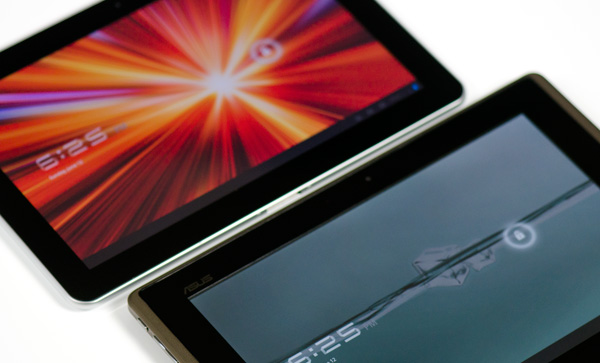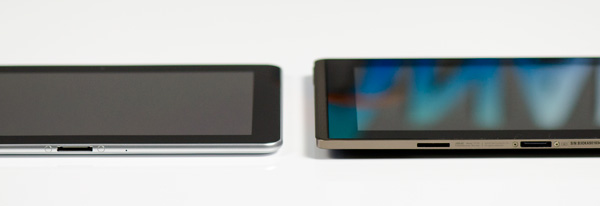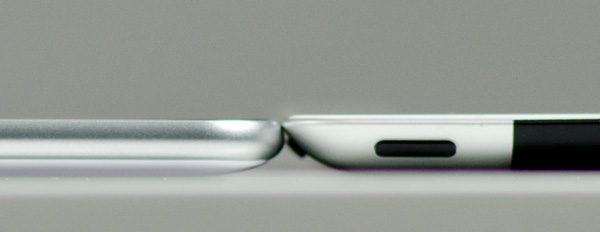Samsung Galaxy Tab 10.1 Review: The Sleekest Honeycomb Tablet
by Anand Lal Shimpi on June 13, 2011 5:07 AM EST- Posted in
- Tablets
- Samsung
- Tegra 2
- Galaxy tab 10.1
- Android 3.1
- Mobile
- NVIDIA
I remember standing in the audience of Samsung's CTIA press conference as it announced, for the first time ever, pricing and availability of its unreleased Galaxy Tab 10.1 and 8.9 before shipping. The smartphone (and early tablet) industries have gone this long without having to really compete based on price, mostly because in North America the carriers subsidize much of the cost. If every device costs $199 under contract, why get carried away with details like how much it actually costs?
The Galaxy Tab however was playing in a different space. While Apple ultimately caved to the pressures of carrier subsidies with the iPhone, the iPad remains completely unsubsidized and its followers buy it by the millions. The magical price point is $499 and it was at Samsung's CTIA press conference that it announced it would be matching Apple's $499 price point, and even dropping slightly below it for the 8.9-inch version.
At the time it seemed like a bold move, enough to give Honeycomb the fighting chance it needed. The Galaxy Tab would be thinner and lighter than the iPad 2 but competitively priced as well. This wouldn't be another Xoom.

Samsung Galaxy Tab 10.1 (top) vs. ASUS Eee Pad Transformer (bottom)
Then ASUS showed up. At $399, the Eee Pad Transformer not only offered a different usage model to the iPad and Galaxy Tab, it brought a lower price tag as well. Availability has been slim thanks to component shortages, but with the Eee Pad selling for $399 the Galaxy Tab at $499 all of the sudden seems overpriced.
| 2011 Tablet Comparison | ||||||
| Apple iPad 2 | ASUS Eee Pad Transformer | Motorola Xoom WiFi | Samsung Galaxy Tab 10.1 | |||
| SoC | Apple A5 (Dual ARM Cortex A9 @ 1GHz) | NVIDIA Tegra 2 (Dual ARM Cortex A9 @ 1GHz) | NVIDIA Tegra 2 (Dual ARM Cortex A9 @ 1GHz) | NVIDIA Tegra 2 (Dual ARM Cortex A9 @ 1GHz) | ||
| GPU | PowerVR SGX 543MP2 | NVIDIA GeForce | NVIDIA GeForce | NVIDIA GeForce | ||
| RAM | 512MB | 1GB | 1GB | 1GB | ||
| Display | 1024 x 768 IPS | 1280 x 800 IPS | 1280 x 800 | 1280 x 800 PLS | ||
| NAND | 16GB | 16GB | 32GB | 16GB | ||
| Dimensions | 241.2mm x 185.7mm x 8.8mm | 271mm x 175mm x 12.95mm | 249.1mm x 167.8mm x 12.9mm | 256.6 x 172.9 x 8.6mm | ||
| Weight | 601g | 695g | 730g | 565g | ||
| Price | $499 | $399 | $599 | $499 | ||
Based on specs alone you'd be right. Samsung's Galaxy Tab 10.1 has the same NVIDIA Tegra 2 tablet SoC inside,
1GB of LPDDR2 and 16GB of NAND on-board. You get a 10.1-inch 1280 x 800 PLS display and 802.11n WiFi support. It's worth pointing out that we're now well into the month of June and NVIDIA continues to be the only SoC vendor shipping in Honeycomb tablets. Samsung originally had plans to ship its own Exynos SoC in the Galaxy Tab but Tegra 2 remains the port of choice for all Honeycomb vendors at this point. Whether or not NVIDIA can win twice in a row with Ice Cream Sandwich later this year remains to be seen.

Samsung Galaxy Tab 10.1 (left) vs. ASUS Eee Pad Transformer (Right)
Where Samsung gives you something more for your money is in build quality and form factor. While Eee Pad Transformer feels surprisingly good for a cost reduced tablet, it doesn't feel nearly as slim or portable as the Galaxy Tab 10.1. It's no wonder Samsung went back to the drawing board on this one, the result is something that in many ways feels better than the iPad 2.
Apple still gets the nod in terms of quality of materials. The aluminum back of the iPad 2 is unbeatable. The Galaxy Tab 10.1 however feels lighter, a bit more rugged (I'm less concerned about scratching plastic than I am marring aluminum) and a little more comfortable to hold as a result. Against the Eee Pad there's no competition. I can live with the Eee Pad, but I much prefer the feel of the Galaxy Tab 10.1. The new Tab just feels like a device from this year - a compliment that, until now, I had only given to Apple.
The Galaxy Tab 10.1 measures just 8.6mm thick, 0.2mm thinner than the iPad 2. To be honest you really can't tell the difference, both devices feel thin. Ever after holding them back to back it's near impossible to tell that Samsung has built a thinner device. The most tangible difference in feel is the weight, not just in overall mass but in terms of weight distribution. The Galaxy Tab seems to carry the weight a bit better than the iPad, a bit more evenly.

Samsung Galaxy Tab 10.1 (left) vs. Apple iPad 2 (right)
Now is as good a time as any to point out that although Samsung calls this the Galaxy Tab 10.1, it's really the new Galaxy Tab 10.1. Originally Samsung announced a much thicker version at Mobile World Congress, a month prior to the CTIA announcement. With the much thinner iPad 2 hitting the market after the original 10.1 announcement, Samsung scrapped plans for the original and unveiled the thinner 8.6mm version as the new Galaxy Tab. The original Galaxy Tab 10.1 is now known as the Galaxy Tab 10.1v.












108 Comments
View All Comments
headbox - Monday, June 13, 2011 - link
With specs like those, I bet Samsung sells hundreds of these!Omid.M - Monday, June 13, 2011 - link
If they sold hundreds, they'd probably shoot themselves. I think you mean hundreds of THOUSANDS :)Good review, Anand, but I think this tablet is unfortunately another stop-gap: I think the true Android tablet will be 8.9" form factor and based off Kal-El, and hopefully in LTE form.
Hardware wise, I don't see much advantage of an iPad 2 over the Tab 10.1, so it boils down to ecosystem and UI philosophy (Honeycomb vs iOS). Well, and SDK; Brian and I have had a brief chat about this :)
-Omid
@moids
bplewis24 - Monday, June 13, 2011 - link
I believe the OP was making a point about the lack of consumer interest in android tablets right now, no matter how good they are.MonkeyPaw - Monday, June 13, 2011 - link
I think its a lack of awareness. iPad. Is just all people know, and its well marketed compared to Android tablets. I have impressed many people with the capabilities of my Nook running CM7. Either people aren't convinced of the value of android tabs, or they are too heavily associating them with cell carriers. They might not think they can be purchased outside of a contract. That, or its hard to beat apple marketing.bplewis24 - Monday, June 13, 2011 - link
I agree on both counts. The mainstream tech media has played a part in this as well as Apple's own marketing. The bottom line is that Anandtech is one of the few tech sites to give Honeycomb tablets positive reviews.KoolAidMan1 - Monday, June 13, 2011 - link
This is really the first one that has deserved positive reviews. The Xoom in particular was garbage. Honeycomb hardware is finally getting there in terms of displays and physical form factor. Once the Tegra 3 gets into Android tablets later this year the hardware will finally give legit competition to the iPad 2.B3an - Monday, June 13, 2011 - link
What are you talking about?Tegra 3 Android tablets wont be competitive with iPad 2 hardware wise, they will be considerably superior.
These Android tablets right now, like the Galaxy Tab 10.1 are already more than competitive on hardware. The Tab 10.1 has twice as much RAM, a better screen, and also higher resolution. The only real area where iPad 2 is unquestionably better is it's GPU. But thats about it. Overall the Tab 10.1 wins on hardware.
KoolAidMan1 - Tuesday, June 14, 2011 - link
Legitimate competition means being superior to the iPad hardware, not as good as or worse than. Otherwise there isn't much point give the app selection and excellent hardware you get with the current iPad. Right now it is a wash or considerably slower, especially when it comes to the GPU as you pointed out.Not hating btw, this is objective reality. I think that the conclusion of the article is correct: if you are on the fence then one should wait. The Xoom was terrible, and while the Transformer and Galaxy 10.1 are huge improvements, the real Honeycomb tablets worth getting excited about will be out later this year once Tegra 3 is in them. That and more developers on board is when we'll see real competition in the tablet space.
PeteH - Tuesday, June 14, 2011 - link
I think it's also worth pointing out that GPU is probably more important to most people's tablet experience than anything else in the silicon.So long as Apple's GPU performance continues to exceed what is available to other tablet manufacturers they will have a significant advantage. And since Apple effectively has more silicon available to it at a given price point compared to their competitors (they only have to pay to fab their chips, they don't have to pay a further markup to someone like NVIDIA) it could be very difficult for anyone to catch them in the near term.
The0ne - Thursday, June 16, 2011 - link
Sometimes I feel as though Android is the brother to Linux :) If it weren't for phones I think pads wouldn't have a chance. Android needs better and more marketing/PR so consumers are aware of them. My nephews own phones with Android but they'll go huh if you as they what OS. Ask an iPhone user and they immediately know because well, it's iphone :D